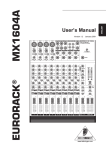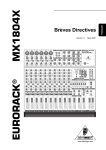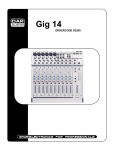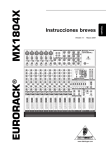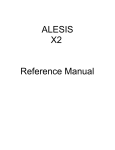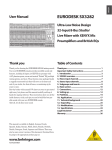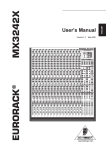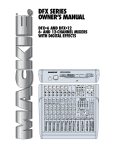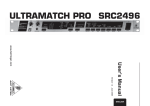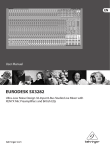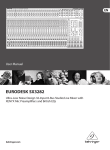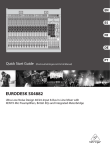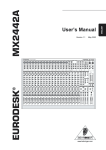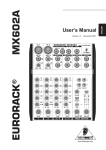Download Behringer EURORACK MX2004A User`s manual
Transcript
Version 1.1 March 2001 EURORACK ® www.behringer.com ENGLISH MX2004A User’s Manual EURORACK MX2004A SAFETY INSTRUCTIONS CAUTION: To reduce the risk of electrical shock, do not remove the cover (or back). No user serviceable parts inside; refer servicing to qualified personnel. WARNING: To reduce the risk of fire or electrical shock, do not expose this appliance to rain or moisture. This symbol, wherever it appears, alerts you to the presence of uninsulated dangerous voltage inside the enclosure—voltage that may be sufficient to constitute a risk of shock. This symbol, wherever it appears, alerts you to important operating and maintenance instructions in the accompanying literature. Read the manual. DETAILED SAFETY INSTRUCTIONS: All the safety and operation instructions should be read before the appliance is operated. Retain Instructions: The safety and operating instructions should be retained for future reference. Heed Warnings: All warnings on the appliance and in the operating instructions should be adhered to. Follow instructions: All operation and user instructions should be followed. Water and Moisture: The appliance should not be used near water (e.g. near a bathtub, washbowl, kitchen sink, laundry tub, in a wet basement, or near a swimming pool etc.). Ventilation: The appliance should be situated so that its location or position does not interfere with its proper ventilation. For example, the appliance should not be situated on a bed, sofa rug, or similar surface that may block the ventilation openings, or placed in a built-in installation, such as a bookcase or cabinet that may impede the flow of air through the ventilation openings. Heat: The appliance should be situated away from heat sources such as radiators, heat registers, stoves, or other appliance (including amplifiers) that produce heat. Power Source: The appliance should be connected to a power supply only of the type described in the operating instructions or as marked on the appliance. Grounding or Polarization: Precautions should be taken so that the grounding or polarization means of an appliance is not defeated. Power-Cord Protection: Power supply cords should be routed so that they are not likely to be walked on or pinched by items placed upon or against them, paying particular attention to cords and plugs, convenience receptacles and the point where they exit from the appliance. Cleaning: The appliance should be cleaned only as recommended by the manufacturer. Non-use Periods: The power cord of the appliance should be unplugged from the outlet when left unused for a long period of time. Object and Liquid Entry: Care should be taken so that objects do not fall and liquids are not spilled into the enclosure through openings. Damage Requiring Service: The appliance should be serviced by qualified service personnel when: - The power supply cord or the plug has been damaged; or - Objects have fallen, or liquid has been spilled into the appliance; or - The appliance has been exposed to rain; or - The appliance does not appear to operate normally or exhibits a marked change in performance; or - The appliance has been dropped, or the enclosure damaged. Servicing: The user should not attempt to service the appliance beyond that is described in the Operating Instructions. All other servicing should be referred to qualified service personnel. 2 EURORACK MX2004A FOREWORD Dear Customer, Welcome to the team of EURORACK users and thank you very much for expressing your confidence in BEHRINGER products by purchasing this unit. It is one of my most pleasant tasks to write this letter to you, because it is the culmination of many months of hard work delivered by our engineering team to reach a very ambitious goal: To produce a compact mixer, which fully satisfies your and our expectations and delivers a superior sound quality, easy operation and technical specifications. In addition to that the mixer is affordable for almost every musician. The task to design the EURORACK certainly meant a great deal of responsibility, which we assumed by focusing on you, the discerning user and musician. It also meant a lot of work and night shifts to accomplish this goal. But it was fun, too. Developing a product usually brings a lot of people together, and what a great feeling it is when everybody who participated in such a project can be proud of what we’ve achieved. It is our philosophy to share our joy with you, because you are the most important member of the BEHRINGER family. With your highly competent suggestions for new products you’ve greatly contributed to shaping our company and making it successful. In return, we guarantee you uncompromising quality (manufactured under ISO9000 certified management system) as well as excellent technical and audio properties at an extremely favorable price. All of this will enable you to fully unfold your creativity without being hampered by budget constraints. We are often asked how we can make it to produce such high-grade devices at such unbelievably low prices. The answer is quite simple: it’s you, our customers! Many satisfied customers means large sales volumes enabling us to get better conditions of purchase for components, etc. Isn’t it only fair to pass this benefit back to you? Because we know that your success is our success, too! I would like to thank the following people, whose help on “Project EURORACK MX2004A” has made it all possible: ▲ The existing users of BEHRINGER equipment (whose comments and suggestions have made them the most important members of the BEHRINGER design team), ▲ Thorsten (for this marvellous manual layout), ▲ Bernhard (Rammi) (whose technical ingenuity is unique), ▲ C.W. for the fine mechanics (key-phrase “Tooling modification”), ▲ and all the others, who have made very personal contributions. My friends, it’s been worth the trouble! Thank you very much, Uli Behringer 3 EURORACK MX2004A MX2004A Ultra low-noise 20-channel, 4-bus mixer s 4 stereo input channels with balanced TRS connectors s 2 additional multi-functional stereo aux returns s Pre and post-fader aux sends for external effects devices and monitoring s Master aux sends with gain control s Extremely high headroom—offering more dynamic range s Ultra low-noise discrete microphone preamps with +48 V phantom power s Balanced inputs and main outputs EURORACK s 8 mono input channels with gold-plated XLRs and phone connectors s Peak LEDs, insert facilities and switchable low-cut filter on all mono channels s Ultra-musical 3-band EQ on all mono channels s Mute/Alt 3-4, solo-in-place and pre-fader-listen function on all channels s Separate main mix, control room and headphones outputs s 2-track inputs assignable to main mix or control room/headphones outputs s Highly accurate 13-digit bargraph meters on output s High-quality faders and sealed potentiometers s Rugged design power supply ensures superior transient response s State-of-the-art 4580 ICs and high quality components ensure crystal-clear audio performance and excellent noise figures s Rugged construction ensures long life even under the most demanding conditions s Manufactured under ISO9000 certified management system 4 EURORACK MX2004A TABLE OF CONTENTS 1. INTRODUCTION..................................................................................................................... 7 1.1 Architecture .................................................................................................................................... 1.2 Before you begin ............................................................................................................................. 1.2.1 PSU (power supply unit) ....................................................................................................... 1.2.2 Warranty ............................................................................................................................... 1.2.3 Packing ................................................................................................................................ 1.2.4 Rack mounting the MX2004A ................................................................................................ 7 8 8 8 8 8 2. MONO INPUT CHANNEL ....................................................................................................... 8 2.1 2.2 2.3 2.4 2.5 Input level setting ............................................................................................................................ 8 Equalizer......................................................................................................................................... 9 Aux sends ...................................................................................................................................... 9 Routing, fading and muting .............................................................................................................. 9 Insert ............................................................................................................................................ 10 3. STEREO INPUT CHANNEL ................................................................................................. 10 3.1 3.2 3.3 3.4 Input level setting .......................................................................................................................... Equalizer....................................................................................................................................... Aux sends .................................................................................................................................... Routing ......................................................................................................................................... 10 10 10 10 4. MAIN SECTION ..................................................................................................................... 10 4.1 4.2 4.3 4.4 4.5 4.6 4.7 Aux sends .................................................................................................................................... 10 Stereo aux returns ......................................................................................................................... 11 Metering ......................................................................................................................................... 11 Solo function .................................................................................................................................. 11 2-track input and output ................................................................................................................ 12 Monitoring ..................................................................................................................................... 12 Alt 3-4 output ................................................................................................................................ 12 5. SETTING UP ......................................................................................................................... 13 5.1 5.2 5.3 5.4 5.5 5.6 5.7 Selecting inputs ............................................................................................................................ Initializing channels for gain setting ............................................................................................... Auditioning a signal and setting up a channel ................................................................................ Desk normalization ....................................................................................................................... Multitrack initialization .................................................................................................................. Recording levels ............................................................................................................................ Track sheet ................................................................................................................................... 13 13 13 13 14 14 14 6. APPLICATIONS ..................................................................................................................... 14 6.1 6.2 6.3 6.4 Keyboard mixing, live or in the studio ............................................................................................ Live gig with simultaneous 2-track recording ................................................................................. Project studio—laying vocals to tape ............................................................................................ Patchbay ...................................................................................................................................... 6.4.1 Patchbay configuration ........................................................................................................ 6.4.2 Parallel ............................................................................................................................... 6.4.3 Half-normalled ..................................................................................................................... 6.4.4 Normalled ........................................................................................................................... 6.4.5 Open ................................................................................................................................... 6.4.6 Patchbay organization ........................................................................................................ 6.4.7 Looming problems .............................................................................................................. 14 15 16 17 17 18 18 18 18 19 20 5 EURORACK MX2004A 7. TECHNICAL BACKGROUND .............................................................................................. 20 7.1 Mixing ........................................................................................................................................... 20 7.1.1 Equalization ........................................................................................................................ 20 7.1.2 Gain optimization ................................................................................................................ 21 8. INSTALLATION ..................................................................................................................... 21 8.1 8.2 8.3 8.4 EURORACK MX2004A connections .............................................................................................. Connections .................................................................................................................................. Modifications ................................................................................................................................. Expanding ..................................................................................................................................... 21 22 24 24 9. SPECIFICATIONS ................................................................................................................. 25 10.WARRANTY ........................................................................................................................... 26 6 EURORACK MX2004A 1. INTRODUCTION Congratulations. In purchasing our EURORACK you have acquired a mixer with incredible versatility and audio performance. Your EURORACK is built to the same outstanding quality as our top-of-the range console, the BEHRINGER EURODESK MX9000. Later we will see how adding the BEHRINGER ULTRALINK PRO MX882 to your system can inexpensively expand the capacity and flexibility of you mixing power even further. First of all, however, we want to take you on a guided tour of your new rack-mounted console—the BEHRINGER EURORACK MX2004A. We recommend that you experiment with your EURORACK away from the pressures of a recording session or live concert, in order to get a feel for it. It is a musical instrument. Learn to play it well. Next to the specifications you will find some pages with drawings showing the front and rear panel of your EURORACK respectively. Keep them turned over, lying to the left of the text pages, while studying the manual. All functions will be numbered consistently throughout the manual, whether they be in the text or on an illustration. Most specialist subjects are not really all that difficult provided you understand the language used, and the vocabulary of mixing is pretty straightforward. Nevertheless it is as well to be clear about what certain terms mean. A “slot” in a recorder will always be referred to as a track, while that in a mixer will invariably be a channel. I will attempt to be as unambiguous as possible with terms, since much confusion can arise from sloppy definitions. 1.1 Architecture The configuration is 20 into 4 (2+2) into 2. There are eight mono channels, four stereo channels and two stereo aux returns. In addition there is a 2-track input routable to the main mix. A channel is always routed to the main mix outs unless Alt 3-4 is selected, in which case its signal is sent to outputs 3 and 4 instead. Outputs 3 and 4 may be blended with the main mix at the control room output via a switch . Mono input channels Channels 1 to 8 are mono, with a choice of balanced microphone or line inputs. The vintage-style high-current discrete microphone amps are of the same incredible quality as those found on the acclaimed BEHRINGER EURODESK MX9000, while a large external power supply ensures low noise and superior transient response at all times. Stereo input channels A further 8 line inputs on the MX2004A are configured as 4 stereo input channels. These are ideal for multitrack tape returns, or for accepting outputs from MIDI and other electronic instruments. Channel outputs A high-quality true logarithmic 60-mm fader feeds the main mix or Alt 3-4 bus via the channel pan. Aux sends There are two aux send buses on the MX2004A. Stereo aux returns (stereo line inputs) The stereo aux returns lie directly above the master aux sends. These can be routed to the cue send (i.e. aux send 1 set to pre-fader) directly by pressing , in order to enable performers to get a “wet” foldback mix. The aux returns may also be used for mixing in extra MIDI instruments etc. Main mix output Main mix output level is via a pair of high-quality true-log 60-mm stereo faders and is monitored by a pair of accurate 13-segment bargraph peak meters, surrounded by 4 status LEDs. In addition, your MX2004A provides an adjustable phones output, a separate 2-track in/output and the abovementioned Alt 3-4 output. Channels 1 to 8 have overload LEDs, while the L and R outputs have 13-segment bargraph meters. The L/R meters double up as mono PFL or stereo solo meters. The meters should average around 0 dB during loud passages. If they read persistently higher, or are peaking above +10 dB, reduce either the main L/R faders and/ or channel faders, or channel input gain. Perhaps the PFL sequence should be repeated. 1. INTRODUCTION 7 EURORACK MX2004A 1.2 Before you begin 1.2.1 PSU (power supply unit) Any amplifier circuit is limited in its transient response by the available current. Every mixer has numerous line level operational amplifiers (op-amps) inside. When being driven hard, many desks begin to show signs of stress due to power supply limitations. Not so with the EURORACK MX2004A. The sound will always stay clean and crisp right up to the operating limits of the op-amps themselves, thanks to our generous 40 W external power supply unit. Please connect the PSU with the EURORACK MX2004A PSU connector and switch on your MX2004A with the POWER switch . + on the rear panel of your mixer Do not connect the PSU to the EURORACK while the PSU is connected to the mains supply. Connect switched-off desk and PSU first before you connect the PSU to the mains supply. Lastly switch on desk. 1.2.2 Warranty Please take the time to have the warranty card filled out completely by your specialized dealer, and return it within 14 days after the date of purchase, so as to be entitled to benefit from our extended warranty. You may also use our online registration option available on the Internet at www.behringer.com. You will find the serial number of your MX2004A on the rear panel. 1.2.3 Packing Your BEHRINGER EURORACK was carefully packed in the factory and the packaging was designed to protect the unit from rough handling. Nevertheless, we recommend that you carefully examine the packaging and its contents for any signs of physical damage, which may have occurred in transit. + If the unit is damaged, please do NOT return it to us, but notify your dealer and the shipping company immediately, otherwise claims for damage or replacement may not be granted. Shipping claims must be made by the consignee. 1.2.4 Rack mounting the MX2004A Enclosed in the shipping box you will find a 19" rackmount kit. If you want to make your MX2004A a rack mixer, loosen the screws from the side panels and use them to fix the rack ears (note, that there is a left and a right one). + + Be sure that there is enough space around the unit for cooling and please do not place the MX2004A on high temperature devices such as power amplifiers etc. to avoid overheating. When switched on, parts of the desk and the power supply unit will become very warm, which is normal during operation. 2. MONO INPUT CHANNEL Each channel is equipped with a balanced line input 1/4" TRS connector . Phantom powering is switchable from the back panel . + , and an XLR microphone input When using the microphone input please make sure nothing is connected to the same channel’s line input, and vice versa. The gain circuit has an unusually wide range, obviating the need for mic/line switching. The crucial operating levels +4 dBu and -10 dBV are clearly and accurately marked . 2.1 Input level setting Channel input level is determined by the GAIN control . Use the PFL/SOLO switch to bring the channel input onto the left and right bargraph meters respectively. This also sends the PFL/solo-ed signal to the left and right speakers. 8 2. MONO INPUT CHANNEL EURORACK MX2004A For level-setting (as opposed to localized listening) select the mono PFL bus rather than the post-fader (postchannel pan) stereo solo bus (CHANNEL MODE global switch up). PFL/solo never interrupts the mix at the main recording outputs. It follows that aux sends must also be unaffected, since they contribute directly to the main mix. In addition to switchable PFL/solo metering, a channel LED illuminates when a channel is going into overload. You do not want the overload light to come on except very intermittently during a take or a mix. If it does light persistently, reduce input gain (see also chapter 5 “SETTING UP”). There is a steep low-cut (high pass) filter explosives, woolly bottom end etc. , slope at 18 dB/oct., -3 dB at 75 Hz, for reducing floor rumble, 2.2 Equalizer All mono input channels are fitted with 3-band EQ and the above mentioned switchable low-cut filter for eliminating unwanted subsonics. All three bands have up to 15 dB of cut and boost, with a centre detent for “off”. The upper and lower shelving controls have their frequencies fixed at 12 kHz and 80 Hz respectively. The midrange control is semi-parametric with a peaking response, Q fixed at 1 octave. The gain is set with control , the center frequency can be adjusted with control ranging from 100 Hz to 8 kHz. 2.3 Aux sends Both aux sends are mono and post-EQ. Aux send 1 can be taken from a point before or after the channel fader, i.e. pre or post by . Aux send 2 is always wired post-fader. For almost all FX send purposes, you will want aux sends to be post-fader, so that when a fader level is adjusted, any reverb send from that channel follows the fader. Otherwise, when the fader is pulled down, the reverb from that channel would still be audible. For cueing purposes, aux sends will usually be set pre-fader, i.e. independent of the channel fader and mute. Most reverbs etc. sum internally the left and right inputs. The very few that don’t may be driven in true stereo by using 2 aux sends. There is +15 dB of gain on every aux send. Such a high boost is usually only appropriate where the channel fader is set around -15 dB or lower. Here, an almost exclusively “wet” signal will be heard. In most consoles, such a wet mix requires the use of a pre-fader setting for the channel aux send, losing fader control. With the EURORACK you can have a virtually wet mix with fader control. 2.4 Routing, fading and muting Level to the main mix and Alt 3-4 buses is ultimately determined by the channel faders . These are specially manufactured for BEHRINGER mixing consoles, and are designed to give a smooth logarithmic taper of a type more usually associated with very expensive consoles. The performance, at low levels particularly, is far smoother than that of a normal “budget” fader. Channel pan positions the output of the channel in the stereo field. Its constant-power design ensures there are no level discrepancies whether a signal is hard-panned, center-stage, or somewhere in-between. Such pinpoint accuracy will be a revelation if you have been working on consoles with lower quality circuits. Channel pan also determines the stereo position of any signal routed to the Alt 3-4 bus ( depressed). PFL/solo were encountered in chapter 3.1. Solo also follows channel pan. The MUTE/ALT 3-4 button is ergonomically placed immediately above the channel fader. Engaging mute, indicated by , is equivalent to setting a fader level of minus infinity. On the MX2004A the MUTE/ALT 3-4 button serves two functions. When mixing directly to stereo, it acts as a normal mute. However, this button also acts as a routing button to the Alt 3-4 outputs. In other words, you select between the main mix and Alt 3-4 stereo buses via . This is very useful when submixing live or recording to multitrack, as we shall see later. 2. MONO INPUT CHANNEL 9 EURORACK MX2004A 2.5 Insert Insert points are useful for adding dynamic processing or equalization to a channel or the mix. Unlike reverbs etc., which are usually added to the dry signal, dynamic processing is normally applied across an entire signal. Here an aux send would be inappropriate. Instead the signal is intercepted somewhere along the channel, fed through the dynamics processor and/or EQ, then returned to the console at the same point where it left. The insert point is normalized, i.e. the signal is only interrupted when a jack is plugged into it. 3. STEREO INPUT CHANNEL Each stereo channel comes with two balanced line level inputs on 1/4" TRS connectors, for left and right signals. When only the left input is connected, the channel operates in mono. 3.1 Input level setting The stereo inputs are designed for any line level signal. Most line level sources such as MIDI instruments and FX units will have their own output level control. Those that don’t, for example CD players, all have an output level within the scope of the MX2004A. When the channel and master fader are set to unity gain the meters should read between -4 and +7 dB. Remember that there is 15 dB gain on both the channel as well as master fader. 3.2 Equalizer The stereo input channels are fitted with 4-band EQ. The upper and lower shelving controls have their frequencies fixed at 12 kHz and 80 Hz. The peaking high midrange and low midrange / are fixed at 3 kHz and 500 Hz respectively. A stereo equalizer is generally preferable to using two mono equalizers when EQ-ing a stereo signal, as often discrepancies between left and right settings can occur. 3.3 Aux sends These are the same as for mono channels (see 2.3). Note that a mono sum is taken from the stereo input. 3.4 Routing The only difference here from the mono channel described in 2.4 is in the implementation of the balance control . When a channel is run in stereo, this control functions as a balance control, determining the relative balance of the left and right channel signals being sent to the left and right main mix buses. For example, with the balance control turned fully clockwise, only the right portion of the channel’s stereo signal will be routed to the main mix. Balance also determines the relative amount of left and right channel signals being sent to buses 3 and 4 respectively when Mute/Alt 3-4 is engaged. 4. MAIN SECTION 4.1 Aux sends Master aux send levels are determined by and . These controls have a centre detent indicating unity gain. Don’t worry if your effects unit has no input gain control—you have a further +15 dB available from these outputs. 10 3. STEREO INPUT CHANNEL EURORACK MX2004A 4.2 Stereo aux returns There are two additional stereo line inputs (aux returns 1 and 2) on your MX2004A. Aux returns 1 is permanently assigned to the main mix. If you connect a jack to the left socket only, the aux return 1 operates in mono. Aux return 2 can be switched between the main mix and the cue feed (aux send 1) via a switch FX TO AUX 1 . This enables you to provide a wet (signal with effect i.e. reverb) cue mix for the headphones or foldback speakers. If no connection is made to aux return 2, the signal is “normalled” (connected directly) to aux return 1. Depressing the FX TO AUX 1 switch will then feed the signal from aux return 1 into the cue feed (aux send 1) and can be controlled in level independently with aux return 2. This feature is primarily useful when you are using one effect for the main mix and for the foldback speakers. + When using aux send 1 as a second (pre-fader) effects send and aux return 2 as the effect input, do not engage FX TO AUX 1 switch. The connection from aux return 2 to aux send 1 could cause feedback. However, there are exceptions: For instance if you deliberately want to send one effect into another, e.g. delay into chorus etc. The aux returns are multifunctional. They may be used for returning the outputs of effect units. You can use them as tape returns from a multitrack recorder. They may also be used as extra instrument inputs, especially if your MIDI keyboard or rack supplies a pre-mixed stereo signal. Certain stereo effects produce a perceived imbalance between the left and right channel levels. To correct for this you will have to bring your stereo effect back on a stereo channel, which has a balance control. When applying short left and right delays, the shortest one will always seem loudest. When pitch shifting up and down in wide stereo to thicken a sound, the signal shifted upwards will seem louder than one that goes down. In both cases use the balance control to compensate. When performing any stereo imaging exercise, don’t just rely on the control room monitors. Get a pair of headphones and listen in stereo and in reverse stereo, just in case you have any significant hearing discrepancies. Sometimes an engineer wants to narrow the stereo width of a reverb field. To do this you will have to come back on two mono channels to get independent pan for the left and right signals. 4.3 Metering Main mix/PFL/solo level is displayed on a pair of highly-accurate 13-segment bargraph peak meters . Additional LEDs indicate POWER ON , +48 V phantom power present , and whether the mono PreFader-Listen bus or the stereo solo bus is engaged. 4.4 Solo function The CHANNEL MODE switch channel Solo buttons. determines whether Solo-In-Place or Pre-Fader-Listen is assigned to the Solo Solo is the preferred method for auditioning an isolated signal, or group of signals. Whenever a PFL/SOLO button is pressed, all unselected channels are muted in the monitors. Stereo panning is maintained. The solo bus is derived from the output of the channel pans, aux sends and stereo line inputs. It is always post-fader. PFL Pressing once disengages the stereo solo bus, and replaces it with a separate mono PFL (Pre-FaderListen) bus. All solo signals are reconfigured to PFL. PFL should always be used for gain-setting (see also the essential chapter 5 “SETTING UP”). The L/R meters follow whatever source is being auditioned (the meters won’t make much sense if more than one source is selected!). Selecting PFL/solo does not affect the signal from the L/R recording outputs. Just as well, or every time you wanted to do a quick Solo check during a mix, you’d have to start again! 4. MAIN SECTION 11 EURORACK MX2004A 4.5 2-track input and output Input A 2-track input, on RCA connectors semi-professional audio equipment. / , provides easy connection to DAT and other professional or The 2-track input is primarily for auditioning mix playback from tape. The switch 2 TK the monitors and/or phones. routes this signal to However, it can also be routed to the main mix via the switch 2 TK TO MIX and will act as an additional input for tape playback, MIDI instruments etc. Here switch should be disengaged, or you will be listening to the 2-track signal twice over! With depressed you have another stereo line input available to the mix, useful e.g. for adding the output of a second EURORACK or a BEHRINGER ULTRALINK PRO MX882 to your mix. Output The main mix output is delivered by XLR connectors as by RCA connectors on the front . and TRS connectors Level is ultimately determined by a pair of precision faders on the back panel as well . Although the 2-track output is primarily designed for recording, it can also be used as a PA feed, or as a send to the input of your sampler. Depressing on the rear panel will lower the level at the XLR connectors by 20 dB. 4.6 Monitoring Though most of you will want to audition the main mix most of the time include the Alt 3-4 bus and 2-track playback . there are exceptions. These A single stereo volume control sends the level to the headphones and main monitors . If you want to audition external sources very often, you could connect a hi-fi pre-amp (or tape out) to your 2-track input, allowing you to monitor a variety of extra sources such as vinyl, cassette, CD etc. 4.7 Alt 3-4 output By depressing the MUTE/ALT 3-4 button the main mix. a channel’s output will be routed to the Alt 3-4 output instead of Level to the Alt 3-4 outputs (phone connectors on the back panel) is adjusted by signal PFL-ed ( and up). . Use to have the Alt 3-4 is likely to bewilder newcomers. We want to illustrate how this feature may be used most effectively. Subgroups are commonly used as a mixing aid both live and in the studio, e.g. to combine the outputs from all drum channels onto just 1 or 2 submaster faders. They are also used to route to multitrack recorders (see also sections 9.2 and 12.3). There are no fully-fledged subgroups on the MX2004A. However, the Alt 3-4 bus offers you a second independent stereo submix with its own submaster stereo fader . E.g.: If you want to generate two mono subgroups in addition to the normal main mix stereo bus, patch Alt 3-4 outs back into two mono channels, and use these as Subgroup masters (the subgroup return channels must not be routed to the Alt 3-4 bus themselves, as this would constitute a feedback loop). Engaging mute on any input channel routes to the Alt 3-4 bus. Channel pan now selects between Alt 3-4 outputs (left = 3, right = 4). + Subgroups can be mixes of several channels of sound: don’t be surprised if, once you have set up the input gain correctly, the submaster faders are set higher than “normal” channels. Remember that when Alt 3-4 is in use, you do not have a channel mute facility on your desk: you will have to pull down the fader to silence any channel. 12 4. MAIN SECTION EURORACK MX2004A 5. SETTING UP 5.1 Selecting inputs 1) + Mono channels accept microphone or line inputs. If you are using the microphone input, make sure nothing is connected to the line input (and vice-versa). The microphone inputs are more sensitive than the line inputs. Do not connect microphones with phantom power switched on. Never use unbalanced mic cables with the phantom power switched on ever! Shorting 48 V to earth can cause serious damage. 2) Stereo channels accept -10 dBV or +4 dBu line level signals. Any stereo channel can be run in mono simply by connecting into the left connector only. These channels are suitable for a variety of line-level sources including MIDI instruments and tape returns from multitrack. 3) Stereo line inputs are primarily designed for returning effects units, though these too may be given over to multitrack returns or MIDI instrument outputs. 5.2 Initializing channels for gain setting 1) Set GAIN to minimum and all aux sends to off (fully counter-clockwise). 2) Set EQ to flat (all knobs at 12 o’clock). 3) Where applicable, set LOW-CUT switch very low frequency content. 4) Set CHANNEL MODE to PFL 5) Depress PFL/SOLO switch ON for most microphones, OFF for signals with desired . . 5.3 Auditioning a signal and setting up a channel 1) Provide an input signal i.e. roll the tape. There should also be some activity at the main L/R bargraph meters , indicating the PFL level. 2) For microphone/line inputs: Adjust the GAIN control Continuous signals should not exceed 0 dB. until transient peaks are regularly hitting +6 dB. 3) For stereo line inputs: Adjust the source’s output gain until transients are regularly hitting +6 dB. Continuous signals should not exceed 0 dB. 4) If EQ is used, repeat steps 1 to 3. 5) If an insert is used to patch in a compressor, gate, EQ etc, use the outboard processor’s bypass or effect off switch to A/B monitor the effect. If it does not have a bypass switch or equivalent, you will have to keep connecting and disconnecting the device until you complete the following procedure: Adjust the processor’s output level so that effected and bypassed signals are of comparable level, i.e. “unity” gain. 6) PFL/solo switch UP. Move onto next channel. 5.4 Desk normalization All board settings should be set to the normal default condition before or after every session. Usually faders are set to zero (minus infinity) EQ’s set flat and switched out, trimpots and channel aux sends turned fully counterclockwise etc. Many controls have a natural initial setting. For EQ cut and boost this is centre position. However, some settings, such as selecting pre or post for channel aux sends, will depend on the operating environment (e.g. studio or live), or on a particular engineer’s preferred way of working. 5. SETTING UP 13 EURORACK MX2004A 5.5 Multitrack initialization Set up the multitrack so that any track in “record ready” condition has its input monitored when the tape is stationary. Place all tracks to be recorded into “record ready” status. (Once a recording has been made, these tracks should automatically switch to tape playback. Check that the input levels to each track are optimized before recording commences). 5.6 Recording levels When recording to digital, it’s a good idea to keep the recorder’s peak meters below 0 dB. Most (not all, esp. samplers) read 0 dB with some headroom left. This is because, unlike with analog, the onset of digital distortion is as sudden as it is horrible. If you really want to take your recording level to the limit (and fully exploit for instance 16-bit digital’s 96 dB dynamic range), you’ll have to do some calibrating. How to do it? Well, you could run a tone at 0 dB from the mixer and use that as your DAT reference. But your DAT may be way under its maximum input limit. Probably a better way to work out just how hard you can drive your recorder is to incrementally increase the record level until the onset of digital distortion, subtract, say, 5 or 10 dB, and never exceed that level. Engage “peak hold” on your recorder before recording if you want to confirm that you haven’t. When recording to analog, the tape machine’s VU meters should show around +3 dB on bass, but only around -10 dB for hi hat. Although analogue distortion is more like compression at modest overload levels (often desirable on bottom end), higher frequencies cause saturation even at modest levels (resulting in an unpleasant “crunchiness”). Also, VU meters tend to progressively under-read above 1 kHz, due to their sluggish response time. Hi-hats should read about -10 dB on a VU meter, as against 0 dB for a typical snare drum, and +3 dB or more for a kick drum. Peak meters read more-or-less independent of frequency. Aim for 0 dB recording level for all signals. 5.7 Track sheet When laying out channels for recording or mixing, try to be sensible. Keep toms together, etc. Work out a scheme that suits you and stick to it. A common order is: kick drum, snare, hi-hat, tom-toms (as the audience sees the kit), cymbals (ditto), bass, guitars, keyboards, other instruments, vocals. From session to session and gig to gig you will soon know where you are without hardly ever having to look at your track sheet. 6. APPLICATIONS Experience tells us that the cables in a studio environment get tangled very quickly (inviting mistakes). A patchbay will facilitate patching and repatching considerably. The BEHRINGER ULTRAPATCH PRO PX2000 makes patching easier and trouble free, increasing both ergonomics and productivity. 6.1 Keyboard mixing, live or in the studio This is relatively simple to achieve. Simply use the line inputs to mix stereo or mono outputs from your keyboards. It may be useful to use the Alt 3-4 outs e.g. to control the level of drums versus music. Aux sends may be used either to feed on-stage monitors, artists headphones or effects units. The main mix output should feed the FOH or studio mixer. A typical comprehensive live setup is shown below. 14 6. APPLICATIONS EURORACK MX2004A Source MIDI Instrument #1 MIDI Instrument #2 MIDI Instrument #3 MIDI Instrument #4 MIDI Instrument #5 MIDI Instrument #6 MIDI Instrument #7 MIDI Instrument #8 MIDI Sampler #1 MIDI Sampler #2 MIDI Synth #1 MIDI Synth #2 Effect #1 Effect #2 Aux out 1 Aux out 2 Main Mix out L Main Mix out R Monitor out L Monitor out R Keyboard Mixer Mic/Line Mono/Stereo Line Mono Line Mono Line Mono Line Mono Line Mono Line Mono Line Mono Line Mono Line Stereo Line Stereo Line Stereo Line Stereo Stereo Stereo > Effect (post-fader) > Effect (post-fader) > P.A. > P.A. > Monitor system > Monitor system Input 1 2 3 4 5 6 7 8 9/10 11/12 13/14 15/16 Aux 1 Aux 2 Tab. 6.1: Keyboard mixing, live or in the studio 6.2 Live gig with simultaneous 2-track recording Live Gig with 2-TK recording Source Routing Mic/Line Mono/Stereo Vocals Main Mix Mic Mono Vocals Main Mix Mic Mono Vocals Main Mix Mic Mono Vocals Main Mix Mic Mono Alt 3-4 out Main Mix Line Mono Alt 3-4 out Main Mix Line Mono Bass Drum Alt 3-4 Mic Mono Drum Overhead Alt 3-4 Mic Mono Guitar Alt 3-4 Line Stereo Bass Alt 3-4 Line Stereo Keyboard #1 Main Mix Line Stereo Keyboard #2 Main Mix Line Stereo Effect Stereo CD player Stereo Alt 3-4 out (Instruments) > 2-TK input Aux out 1 > Cue 1 (pre-fader) Aux out 2 > Effect (post-fader) Main Mix out L > Recording (DAT L) Main Mix out R > Recording (DAT R) Monitor out L > P.A. Monitor out R > P.A. Input 1 2 3 4 5 6 7 8 9/10 11/12 13/14 15/16 Aux 1 Aux 2 Tab. 6.2: Live gig with 2-track recording Here some or all mono channels are likely to be tied up with stage microphones. Carefully position these so as to minimize feedback. Try to keep the stage volume as low as possible, as stage sound can interfere with and 6. APPLICATIONS 15 EURORACK MX2004A muddy FOH sound, as well as causing a reduction in feedback thresholds. Don’t forget to notch out troublesome frequencies using a graphic or parametric equalizer, or feedback destroyer (see the BEHRINGER ULTRA-CURVE PRO DSP8024 or the FEEDBACK DESTROYER PRO DSP1124P, which do all of these and more). Use the low-cut filters to eliminate floor rumble, mics popping etc. Switching logic for this setup is: and up, and down, down for channels 1 to 8 except 6. 6.3 Project studio—laying vocals to tape 8-track MIDI project studio with sampler, 8-track recording system, one vocal mic and two effects units: Projekt Studio, laying vocal tracks Source Routing Mic/Line Mono/Stereo Input Vocals Alt 3-4 M Mono 1 Band Main Mix L Mono 2 Band Main Mix L Mono 3 Band Main Mix L Mono 4 Band Main Mix L Mono 5 Band Main Mix L Mono 6 Band Main Mix L Mono 7 Band Main Mix L Mono 8 Sampler #1 Main Mix L Stereo 9/10 Sampler #2 Main Mix L Stereo 11/12 Sampler #3 Main Mix L Stereo 13/14 Sampler #4 Main Mix L Stereo 14/15 Effect #1 Stereo Aux 1 Effect #2 Stereo Aux 2 MX 882 Mix out > 2-Track input Alt 3-4 out > Available Aux out 1 > Effect 1 Aux out 2 > Effect 2 Main Mix out L > Recording (DAT L) Main Mix out R > Recording (DAT R) Monitor out L > Monitor system Monitor out R > Monitor system Tab. 6.3: MX2004A example "Project studio, laying vocals to tape" With largely computer-generated music you will want to have plenty of Line inputs, and an ability to take vocals quickly, efficiently, and with minimal desk disturbance. Often a vocal line is added after the music is almost complete. For this we try not to use a valuable aux send as a cue feed. In general, the mix in the artist’s headphones can be the same as that going into the control room monitors: basically a stereo mix with 1) the vocal channel raised above the “mix” level in volume and 2) any off-putting channels muted. If you intend to take several tracks in quick succession, you can route the channel via the Alt 3-4 bus simultaneously into all tape tracks via a simple junction box, splitter lead, line mixer like our MX882, or patchbay. Note: When using Alt 3-4 to send to tape, you can either audition the signal via the tape recorder track, or by assigning Alt 3-4 to the control room monitors , or both. If you are auditioning the vocalist via both routes, the voice should appear louder to you (and the singer) during a take, but be set properly in the mix during playback. By a benign twist of fate, this is usually exactly what you (and they) want. Note that there are two aux sends and two stereo aux returns. If you want to use more than two effects units, these can either be 1) patched across insert points, 2) inserted between the sampler’s outputs and desk inputs, or 3) driven from the channel insert. If you have invested in the 8-channel BEHRINGER ULTRALINK PRO MX882 for tape monitoring purposes, you can turn the 2-track input into eight line inputs for accepting stereo or mono effects or synths etc. during mixdown. 16 6. APPLICATIONS EURORACK MX2004A Fig. 6.1: Project studio setup example 6.4 Patchbay A patchbay allows to patch the audio signals of most components in your studio from a central point and send them to other units, which makes your entire cabling better structured and is indispensable for professional work. If you want to use your studio as effectively as possible then it is preferable to use a complete patchbay wiring scheme, but even less sophisticated patchbay solutions will benefit smaller studio configurations. 6.4.1 Patchbay configuration The majority of commercially available patchbays include two rows with 24 phone jacks each in a 19" 1 U rack panel. On the rear, either a corresponding number of phone jacks or contacts for soldering signal leads can be found. Each group of four of these phone jacks forms one module. The configuration of some Patchbays can be changed by inserting jumpers or turning individual modules. With the help of our ULTRAPATCH PRO PX2000, an easy-to-use 24-patchbay offering phone jacks throughout, you can easily understand the four different modes. With the ULTRAPATCH PRO you can select between the four different operating modes simply by setting a switch on the upper panel (example: module 17): 6. APPLICATIONS 17 EURORACK MX2004A 6.4.2 Parallel Fig. 6.2: Patchbay mode “parallel” In this mode, all terminals of one module are interconnected. This configuration doesn’t make sense at first glance but is used to split up and send one audio signal (e.g. aux send) to several destinations (e.g. effects devices). 6.4.3 Half-normalled Fig. 6.3: Patchbay mode “half-normalled” In this configuration, the contacts of the two jacks on the rear are interconnected. When you insert a plug into the upper front jack, the signal routed through the rear path is not interrupted. Only when the lower front jack is used will the rear panel route be split up, so that the two upper and the two lower phone jacks are connected to one another. This configuration is called “input break” and is used mainly for insert paths. So you can easily patch the signal from a mixing console channel at the Patchbay without interrupting the signal flow in the channel. 6.4.4 Normalled Fig. 6.4: Patchbay mode “normalled” Here, and in contrast to the “half-normalled” setup, the signal route of the rear phone jacks is interrupted when you insert a plug both into the upper and lower front jacks. 6.4.5 Open Fig. 6.5: Patchbay mode “open” This mode is used to connect devices such as sound modules or CD players having no inputs of their own. This saves space, as you can route the left and right outputs to one module (left - top; right - bottom) or patch two devices to one module (top and bottom). Effects devices and 2-tracks can be configured this way, so the inputs 18 6. APPLICATIONS EURORACK MX2004A and outputs are positioned on top of each other. Basically, the inputs are routed to the bottom and the outputs to the top rear-wall connectors. Avoid routing digital signals over a patchbay as the pulse signal used for the transmission of such signals causes heavy interference in analog signals. Additionally, normal patchbays change the impedance of the digital cable route, which causes interference in the digital path. Use the BEHRINGER ULTRAMATCH SRC2000 specifically designed for this and other digital signal-related functions. Microphone inputs operate at a level several orders of magnitude lower than line levels (+4 dBu or -10 dBV). Therefore, they should never be routed via a patchbay. In any case, patching in a field with 48 VDC (phantom power) flying about is to be avoided at all costs. It is best to plug mics directly into the mixing console or via special XLR-type wall boxes connected to the mic inputs of the console by good-quality balanced multicore cables (2-cond. + shield). 6.4.6 Patchbay organization Let us give you an example configuration that shows how you can most effectively use your patchbays. We assume you own a mixing console with 16 mic/line inputs plus inserts, 8 direct outputs, 8 subgroups with 4 inserts, 4 aux paths with 2 stereo returns and one stereo master output including insert jacks. Added to this we have an 8-track recorder (digital or analog), a few pieces of outboard equipment (FX, dynamics & EQ’s), a CD player, tape deck, HiFi system and a headphones amp: 1 2 3 4 Fig. 6.6: Example of a studio organization with four patchbays In the first eight modules of patchbay 1 the subgroup outputs are directly connected to the corresponding multitrack inputs. In addition to that it is also possible to record the signals coming from a subgroup on a different track of the multitrack. To save space and provide a clearly structured configuration, the direct outputs are connected both to the top and bottom jacks. Modules 17 & 18 are the stereo master output, which is half-normalled and 6. APPLICATIONS 19 EURORACK MX2004A thus allows for recording both to the DAT recorder and the tape deck, simply by patching it accordingly. Modules 19 & 20 (tape deck) are open, because it does not make sense connecting the inputs and outputs of the tape deck. 21 & 22 are normalled and route the DAT recorder outputs to the 2-track inputs of the mixing console. So it always is possible to control the recorded data on the 2-track from the mixing console. The CD player and the HiFi system are connected to modules 23 & 24, which are open, because they only serve as a source. In patchbay 2 the first 16 modules are normalled (1 through 8 IN could also be used to connect the corresponding monitor inputs—if the console has a separate monitor section). MIDI devices such as samplers, expanders, keyboards, etc. are usually set up in every corner of the room. To make the cabling better structured we route these units to modules 9 through 16. This allows further workmanship of the MIDI devices at the mixing console. Modules 17 through 20 are normalled and have the FX inputs and the aux sends connected, 21 through 24 are also normalled and are patched to the two stereo aux returns with the FX outputs. In patchbay 3 , modules 1 through 16 are for the channel insert. These modules are half-normalled, so that you have an additional route for the channel signals. The same applies to the insert paths of the subgroups and the master output. The headphones amp is connected to 23 & 24, which are normalled and connected to the control room outputs of the mixing console. Of course, you can also use pre-fader aux paths for the headphones mix. Patchbay 4 manages the dynamics and frequency-processing devices in an open configuration (modules 1 through 16). Multigates and Compressors should be used here, in particular. Modules 17 through 24 are used to provide a “parallel split”, i.e. two modules are patched to each other on the rear with one patch cord, so that you can split up a signal applied on the front panel to several destinations. These modules have a parallel configuration. It should be noted that patchbays should be placed one below the other in such a way that the patch cords won’t hang all over the patchbays. In our example you don’t have to span great distances, for instance, to patch the dynamics and EQ’s to the insert paths. 6.4.7 Looming problems Loom wiring is an art unto itself, and it is worth taking time out to get it right. First off, it is important to avoid earth loops (a looped wire acts an aerial, picking up hum and electromagnetic radiation). Think of a tree. Every part of that tree is connected to every other part, but only by one route. That’s how the total earth picture for your entire studio should look. Don’t take the earth off your power cable plug to reduce audible 50 Hz mains hum. Rather you should be looking at disconnecting the signal screen somewhere (one or several audio cables). It is good practice to ensure that all screens are commoned at the patchbay, in which case all unearthed equipment would pick up earth from this point via a single screen (more than one route = an earth loop), while mains-earthed equipment would have all screens cut at the equipment end. Some quality equipment has an independent signal and mains earth. In this case at least one screen should carry earth to the equipment. Sometimes the only way to find out is “suck and see”. Take care to ensure that using the patchbay does not disturb the studio’s earth architecture. Always use short as possible patch leads with the screen connected at both ends. Having designed mains hum out of the system, make up your cable looms from the patchbays outwards, and use cable ties, flexible sheaths, multicores, etc. to keep the back of your racks tidy. 7. TECHNICAL BACKGROUND 7.1 Mixing 7.1.1 Equalization Few people buying a mixer will need to be told how an equalizer works. But how to get the best out of it? Well, that’s another story. In the beginning EQ was an instrument for removing unwanted frequencies, or compensating for imperfect microphone response curves, or bumps in a studio’s acoustic. It was a corrective device. Tamla Motown turned that notion upside down in the sixties with the novel idea that you try to find for each instrument a characteristic frequency not shared by the other instruments in the mix. Then you whack up its gain. This makes individual 20 7. TECHNICAL BACKGROUND EURORACK MX2004A voices punch through a mix in a slightly unnatural but exciting way. In general corrective EQ usually involves broadband (slope) contouring, together with narrowband notching of unwanted resonances. The narrower the notch or “Q”, the less the total signal will be affected. Finding bad resonances is made easier by first frequency sweeping in BOOST mode. “Motown” EQ is achieved by applying boost in a fairly broadband way. The broader the band, the more musical but less instrument-specific the effect. Applying boost over a narrow bandwidth will sound “honky”. For sounds which require drastic corrective EQ, it is advisable to have a couple of channels of fully comprehensive Parametric Equalization in your rack. (You can always bounce tracks though the outboard EQ, freeing up the unit for the next task). Check out the BEHRINGER ULTRA-CURVE PRO DSP8024, a superlative digital stereo equalizer and much, much more. Or our ULTRA-Q PRO PEQ2200 5-band constant-Q state-variable analog EQ. For “advanced equalization”, EQ might be applied to a signal as follows: First, trim the LF and HF shelves to achieve the required slope or “loudness”. Now use a parametric EQ band to boost the most significant frequency for each instrument or tape track. Over all channels, if two or more of these frequencies coincide, then you might have to settle for second best in some cases, if you want to achieve optimum separation in the mix. Really nasty frequencies will need notching out. A good vocal signal can be enhanced by applying a significant boost in the 12 kHz region or higher, above the nasty sibilance region. This is especially effective if you’ve got a de-esser patched post-EQ. + Use the low-cut to tighten up channels in a mix: maybe remove it only for the bass, kick drum, toms, tablas, didgeridoo and other deliberate subsonics (when recording classical music ignore this advice). With the LF set to boost, and the low-cut switch activated, you have pretty much got a peak response rather than shelving at the bottom. Good for tight but deep bass. Remember EQ contouring can be done with cut as well as with boost. Cutting away the top and bottom, then pushing up the gain is equivalent to mid range boost! EQ is not a one way street! Always re set a channel’s input gain (or external devices’ output level) after altering the amount of desk EQ cut or boost applied. 7.1.2 Gain optimization PFL (Pre-Fader-Listen) is the way to set a desk level. Master aux send levels are fixed at unity gain. As the mix progresses, more and more channels are likely to be sending to effects via the aux buses, and it’s best to PFL all sends just before setting up for the final mix. Outboard reverbs etc. should all be made to work hard. There’s no point in having an 85 dB dynamic range if the input meter of your reverb is barely flickering. On the other hand, digital distortion is not one of the nicer noises around. You’ll have to rely on your ears to detect digital distortion, since different outboard processors calibrate their meters differently. If you hear distortion, turn down the input on the FX unit, and turn up the desk’s aux return input. 99 times out of 100 distortion in the aux send > FX > aux return loop will come from the FX unit (FX gain too high), and the same goes for a high noise level (FX gain too low). Analog multitrack tape should be driven quite hard, since its dynamic range (without noise reduction) is likely to be 20 to 30 dB worse than other elements in the recording chain. Try to record bright. You can always mix back duller. Brightening up an off-tape signal will bring up the level of tape noise. With digital tape or hard disk you have plenty of dynamic range, and treble pre-emphasis is not often necessary. Just don’t let the signal distort! When mixing or recording, keep the channel fader levels around or below 0 dB. If you do find the faders creeping up or down, apply a suitable offset over all channel faders, and try to control your bad habit in future! 8. INSTALLATION 8.1 EURORACK MX2004A connections Follow us on a walk along the rear panel of your EURORACK, starting left: 8. INSTALLATION 21 EURORACK MX2004A AC Power In. For connecting the mixer to the power supply unit (PSU). Always connect mixer and PSU before you connect the PSU to the mains supply. POWER switch. Once the PSU is connected to the mains supply, you may switch on your EURORACK. Allow one minute after powering up for the system to equilibrate before setting input gains. + PHANTOM switch. When using condenser microphones, +48 V DC can be switched globally on or off for all microphone channels. Care should be taken not to plug microphones into the console (or stagebox) while the phantom power is on. Also, mute the monitor/PA speakers when turning phantom power on or off. Let’s now have a look an all the inputs and outputs on the EURORACK. Most of them are balanced. Unbalanced equipment may be connected to balanced inputs/outputs. Either use 1/4" phone connectors or connect ring and sleeve of 1/4" TRS connector (or leave pin 3 of XLR plugs unused). Main outputs (XLR) Balanced XLR, wired pin 1 ground/screen, pin 2 hot (+ve), pin 3 cold (-ve). Maximum level is +28 dBu. MAIN OUTPUT LEVEL switch Level to the XLR main outputs (+4 dB) will be lowered to microphone level, if you depress can route the lowered output signal directly to the microphone inputs of another console. . E.g. you Main output Unbalanced 1/4" phone connectors, wired tip = signal, sleeve = ground/screen. Alt 3-4 output Unbalanced 1/4" phone connectors, wired tip = signal, sleeve = ground/screen. Let us now move onto the front panel of your EURORACK MX2004A. Mono input channels 1 to 8 Mic inputs Balanced XLR, wired pin 1 = ground/screen, 2 = hot (+ve), 3 = cold (-ve). Remember the PHANTOM switch . Line inputs Balanced 1/4" TRS connectors, wired tip = hot (+ve), ring = cold (-ve), sleeve = ground/screen. Stereo input channels 9/10 to 15/16 Four stereo pairs. Balanced 1/4" TRS connectors, wired tip = hot (+ve), ring = cold (-ve), sleeve = ground/screen. Stereo aux returns 1/2 Two stereo pairs. Unbalanced 1/4" phone connectors, wired tip = signal, sleeve = ground/screen. Aux sends 1/2 Unbalanced 1/4" phone connectors, wired tip = signal, sleeve = ground/screen. 2-track in/out RCA connectors for use with tape recorders etc., signal = main mix. Control room outputs Will feed a pair of speakers (via an amp, of course unbalanced 1/4" phone connectors, wired tip = signal, sleeve = ground/screen. Phones outputs Will feed headphones. 1/4" TRS connector, wired tip = left signal, ring = right signal, sleeve = ground/ screen. 8.2 Connections You will need a lot of cables for different purposes—see the following figures to make sure you have the right ones. Unbalanced equipment may be connected to balanced inputs/outputs. Either use mono 1/4" phone connectors or connect ring and sleeve of 1/4" TRS connectors. 22 8. INSTALLATION EURORACK MX2004A Fig. 8.1: Different connector types 8. INSTALLATION 23 EURORACK MX2004A 8.3 Modifications The following modifications require you to do some soldering. Attempt only if you are experienced in using an iron on PCBs. Otherwise, refer to qualified personnel. After modification the BEHRINGER warranty becomes discretionary. Links should not be threaded into holes on the PCB. They should be soldered to the tinned areas around the holes, and bowed slightly upwards in between. Mono channel aux send 2 > pre-fader Mono channel aux sends 2 are post-fader. If you want to convert them, carry out the modification described below to each mono channel you want to be altered. The right PCB area is indicated by a yellow printing (see figures below). 1) Switch desk off and disconnect it from the mains supply! 2) Cut the “post” track. 3) Add in a “pre” link. Repeat for all mono channels you want to be modified. Modification on Mono Channels AUX AUX PRE PRE Add a ´pre´ link Cut the ´post´ track POST POST JPn JPn Before After Fig. 8.2: Modifications 8.4 Expanding When the EURORACK is your main mixer, you may find that you run out of inputs as your system expands. It is possible to expand your mixing system by combining two or more mixers. Adding extra Line inputs to your EURORACK: A small line mixer (such as the BEHRINGER ULTRALINK PRO MX882) can inexpensively add extra line inputs to your console. With the ULTRALINK PRO, any stereo, line-level input on your EURORACK can become a stereo line input plus a further 6 panable mono line inputs. Great for adding tape monitor returns etc. Linking two EURORACK: Simply take the main mix output of one, and feed it into a suitable stereo line input of the second. Linking the EURORACK to a master console: Feed any or all of the main mix, Alt 3-4 and aux outputs from your EURORACK into separate channels of the master console. The aux outputs should be routed only to individual aux send buses on the master console. Now the aux sends from the EURORACK can access effects currently used by the master console. The EURORACK outputs are essentially submixes of several channels of sound, and are therefore likely to be considerably higher than the typical source signals (coming from mics, MIDI instruments or tape) seen by the remaining channels of the master console or the 2nd EURORACK. A usefull feature here is the 20 dB pad buttons on the back panel. These buttons enable you to feed the balanced output of the MX2004A to the microphone input of another console. This way it is possible to make for instance a separate keyboard or drum kit mix and feed that to the front of house console (without having to use XLR to jack adapters to feed the Line inputs which may also be unbalanced). 24 8. INSTALLATION EURORACK MX2004A 9. SPECIFICATIONS Mono input channels Mic input Frequency response Distortion (THD & N) Mic E.I.N. (22 Hz - 22 kHz) Gain range Signal-to-noise ratio electronically balanced, discrete input configuration 10 Hz to 60 kHz, +/- 3 dB 0.007% @ +4 dBu, 1 kHz, bandwidth 80 kHz -129.5 dBu, 150 Ohm source -117.3 dBqp, 150 Ohm source -132.0 dBu, input shorted -122.0 dBqp, input shorted +10 dB to +60 dB 113,6 dB Line input Frequency response Distortion (THD & N) Gain range electronically balanced 10 Hz to 60 kHz, +/- 3 dB 0.007% @ +4 dBu, 1 kHz, bandwidth 80 kHz +10 dBu to -40 dBu EQ Low Mid High 80 Hz, +/- 15 dB, Q=2 100 Hz to 8 kHz, +/- 15 dB, Q=1 12 kHz, +/- 15 dB, Q=2 Stereo input channels Line input Frequency response Distortion (THD & N) unbalanced 10 Hz bis 55 kHz, +/- 3 dB 0.007% @ +4 dBu, 1 kHz, bandwidth 80 kHz EQ Low Low Mid Hi Mid High 80 Hz, +/- 15 dB, Q=2 500 Hz, +/- 15 dB, Q=2 3 kHz, +/- 15 dB, Q=2 12 kHz, +/- 15 dB, Q=2 Main mix Max. output Aux Sends max. output Signal-to-noise ratio Noise (absolute) Power supply Mains voltage Physical Dimensions (H * W * D) Net weight Total weight +28 dBu, balanced, XLR +22 dBu, unbalanced, 1/4" phone connectors +22 dBu, unbalanced 112 dB bus noise, fader 0 dB, channels muted: -100.0 dBr (ref.: +4 dBu) fader 0 dB, all input channels assigned and set to unity gain: -88.5 dBr (ref.: +4 dBu) U.S.A./Canada U.K./Australia Europe Japan 115 V ~, 60 Hz, power supply MXUL1 240 V ~, 50 Hz, power supply MXUK1 230 V ~, 50 Hz, power supply MXEU1 100 V ~, 60 Hz, power supply MXJP1 app.1½"/3½" (40/90 mm) x 16¼" (410 mm) x 15¼" (385 mm) app. 6 kg (PSU not included) app. 8 kg BEHRINGER is constantly striving to maintain the highest professional standards. As a result of these efforts, modifications may be made from time to time to existing products without further notice. Specifications and appearance may differ from those listed or illustrated. 9. SPECIFICATIONS 25 EURORACK MX2004A 10. WARRANTY § 1 WARRANTY CARD/ONLINE REGISTRATION To be protected by the extended warranty, the buyer must complete and return the enclosed warranty card within 14 days of the date of purchase to BEHRINGER Spezielle Studiotechnik GmbH, in accordance with the conditions stipulated in § 3. Failure to return the card in due time (date as per postmark) will void any extended warranty claims. Based on the conditions herein, the buyer may also choose to use the online registration option via the Internet (www.behringer.com or www.behringer.de). § 2 WARRANTY 1. BEHRINGER (BEHRINGER Spezielle Studiotechnik GmbH including all BEHRINGER subsidiaries listed on the enclosed page, except BEHRINGER Japan) warrants the mechanical and electronic components of this product to be free of defects in material and workmanship for a period of one (1) year from the original date of purchase, in accordance with the warranty regulations described below. If the product shows any defects within the specified warranty period that are not due to normal wear and tear and/or improper handling by the user, BEHRINGER shall, at its sole discretion, either repair or replace the product. 2. If the warranty claim proves to be justified, the product will be returned to the user freight prepaid. 3. Warranty claims other than those indicated above are expressly excluded. § 3 RETURN AUTHORIZATION NUMBER 1. To obtain warranty service, the buyer (or his authorized dealer) must call BEHRINGER (see enclosed list) during normal business hours BEFORE returning the product. All inquiries must be accompanied by a description of the problem. BEHRINGER will then issue a return authorization number. 2. Subsequently, the product must be returned in its original shipping carton, together with the return authorization number to the address indicated by BEHRINGER. 3. Shipments without freight prepaid will not be accepted. 3. Free inspections and maintenance/repair work are expressly excluded from this warranty, in particular, if caused by improper handling of the product by the user. This also applies to defects caused by normal wear and tear, in particular, of faders, potentiometers, keys/buttons and similar parts. 4. Damages/defects caused by the following conditions are not covered by this warranty: s misuse, neglect or failure to operate the unit in compliance with the instructions given in BEHRINGER user or service manuals. s connection or operation of the unit in any way that does not comply with the technical or safety regulations applicable in the country where the product is used. s damages/defects caused by force majeure or any other condition that is beyond the control of BEHRINGER. 5. Any repair or opening of the unit carried out by unauthorized personnel (user included) will void the warranty. 6. If an inspection of the product by BEHRINGER shows that the defect in question is not covered by the warranty, the inspection costs are payable by the customer. 7. Products which do not meet the terms of this warranty will be repaired exclusively at the buyer’s expense. BEHRINGER will inform the buyer of any such circumstance. If the buyer fails to submit a written repair order within 6 weeks after notification, BEHRINGER will return the unit C.O.D. with a separate invoice for freight and packing. Such costs will also be invoiced separately when the buyer has sent in a written repair order. § 5 WARRANTY TRANSFERABILITY This warranty is extended exclusively to the original buyer (customer of retail dealer) and is not transferable to anyone who may subsequently purchase this product. No other person (retail dealer, etc.) shall be entitled to give any warranty promise on behalf of BEHRINGER. § 4 WARRANTY REGULATIONS § 6 CLAIM FOR DAMAGES 1. Warranty services will be furnished only if the product is accompanied by a copy of the original retail dealer’s invoice. Any product deemed eligible for repair or replacement by BEHRINGER under the terms of this warranty will be repaired or replaced within 30 days of receipt of the product at BEHRINGER. 2. If the product needs to be modified or adapted in order to comply with applicable technical or safety standards on a national or local level, in any country which is not the country for which the product was originally developed and manufactured, this modification/adaptation shall not be considered a defect in materials or workmanship. The warranty does not cover any such modification/adaptation, irrespective of whether it was carried out properly or not. Under the terms of this warranty, BEHRINGER shall not be held responsible for any cost resulting from such a modification/adaptation. Failure of BEHRINGER to provide proper warranty service shall not entitle the buyer to claim (consequential) damages. In no event shall the liability of BEHRINGER exceed the invoiced value of the product. § 7 OTHER WARRANTY RIGHTS AND NATIONAL LAW 1. This warranty does not exclude or limit the buyer’s statutory rights provided by national law, in particular, any such rights against the seller that arise from a legally effective purchase contract. 2. The warranty regulations mentioned herein are applicable unless they constitute an infringement of national warranty law. The information contained in this manual is subject to change without notice. No part of this manual may be reproduced or transmitted in any form or by any means, electronic or mechanical, including photocopying and recording of any kind, for any purpose, without the express written permission of BEHRINGER Spezielle Studiotechnik GmbH. BEHRINGER, EURORACK, VIRTUALIZER, FEEDBACK DESTROYER, ULTRA-CURVE und ULTRA-Q are a registered trademarks. ALL RIGHTS RESERVED. © 2001 BEHRINGER Spezielle Studiotechnik GmbH. BEHRINGER Spezielle Studiotechnik GmbH, Hanns-Martin-Schleyer-Str. 36-38, 47877 Willich-Münchheide II, Germany Tel. +49 (0) 21 54 / 92 06-0, Fax +49 (0) 21 54 / 92 06-30 26 10.WARRANTY



























